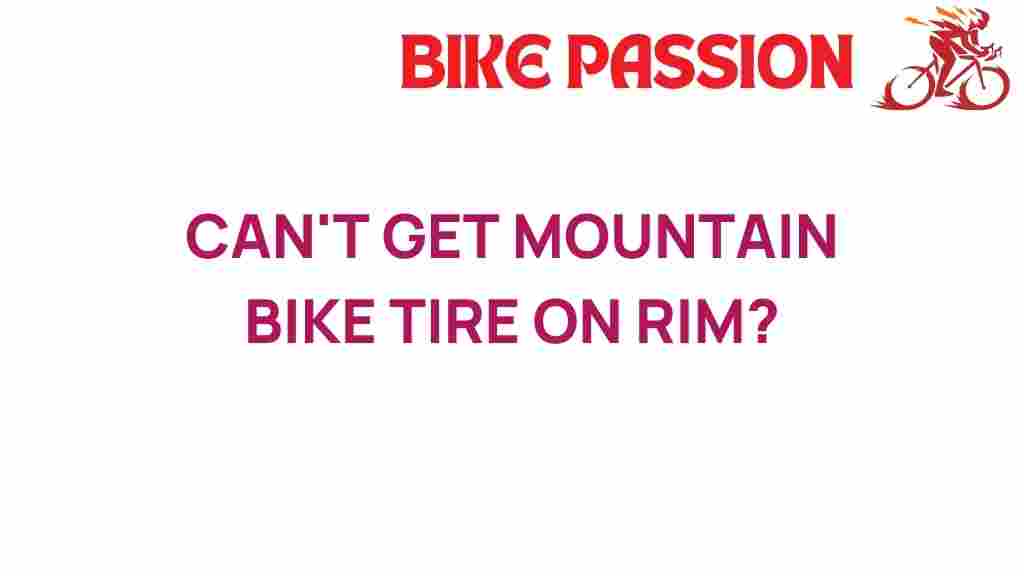Mastering the Art of Mounting: Overcoming Mountain Bike Tire Challenges
Mountain biking is an exhilarating sport that takes you through nature’s toughest terrains. However, every mountain biker faces the inevitable challenge of tire mounting. Whether it’s dealing with flat tires or installing new tires, mastering tire installation is crucial for a smooth ride. In this guide, we will provide you with essential cycling tips, effective bike maintenance practices, and troubleshooting strategies to conquer your mountain bike tire challenges.
Understanding Your Mountain Bike Tire and Rim
Before diving into the tire mounting process, it’s essential to understand the components you’ll be working with. Mountain bike tires come in various sizes and types, including tubeless and traditional tube tires. The rim is the circular metal structure that holds the tire. Here are a few terms you should be familiar with:
- Tire Bead: The edge of the tire that sits on the rim.
- Rim Width: The width of the rim, which affects tire compatibility.
- Tire Size: Denoted in inches or millimeters, e.g., 26”, 27.5”, or 29”.
- Inner Tube: A rubber tube that holds air within the tire (for non-tubeless systems).
Essential Tools for Tire Installation
To successfully mount a tire on your mountain bike, you will need some essential tools:
- Tire levers
- Hand pump or floor pump
- Patch kit (for repairing flat tires)
- Wrench (if applicable)
- Soapy water (for tubeless setups)
Step-by-Step Process for Mountain Bike Tire Mounting
Now that you’re familiar with the components and tools needed, let’s walk through the tire mounting process.
1. Preparing Your Bike
Start by flipping your bike upside down or securing it in a bike stand. This provides easy access to the wheels.
2. Removing the Old Tire
To remove the old tire:
- If you have quick-release wheels, open the lever and remove the wheel from the bike.
- Using tire levers, pry one side of the tire bead off the rim. Insert the lever under the bead and push down to lift it over the rim.
- Once one side is off, remove the inner tube if applicable and then work around the rim to take off the other side.
3. Inspecting the Rim and Tire
Before installing a new tire, inspect the rim for damage and clean it if necessary. Similarly, check the new tire for defects or debris.
4. Installing the New Tire
Follow these steps for proper installation:
- Start by placing the inner tube inside the tire if you’re using a tube.
- Align the tire bead with the rim, ensuring the valve stem is correctly positioned.
- Using your hands, push the bead of the tire onto the rim. Avoid using tire levers unless necessary, as they can damage the tire or rim.
- If you’re installing a tubeless tire, apply soapy water to the bead to aid installation. Inflate the tire to seat it properly on the rim.
- Check for any bulges or irregularities once the tire is inflated.
5. Reinstalling the Wheel
Once the tire is mounted and inflated, reinstall the wheel onto the bike. Ensure that it is securely fastened and spins freely.
Troubleshooting Common Tire Installation Issues
Even with the best practices, challenges can arise during tire mounting. Here are some common issues and how to resolve them:
1. Tire Won’t Seat Properly
If the tire isn’t sitting evenly on the rim:
- Deflate the tire and try to reseat it properly.
- Check for any debris between the tire and rim.
2. Flat Tires After Installation
If you experience a flat tire shortly after installation:
- Inspect the tire for any punctures or leaks.
- Check the inner tube for pinch flats caused by improper installation.
3. Difficulty Inflating the Tire
If you’re having trouble inflating your tire:
- Make sure the valve stem is properly seated and not leaking air.
- For tubeless setups, check if the tire is correctly seated on the rim.
Maintaining Your Mountain Bike Tires
Regular maintenance is key to preventing issues with mountain bike tires. Here are some essential bike maintenance tips:
- Check Tire Pressure: Regularly check and maintain the recommended tire pressure for optimal performance.
- Inspect for Wear: Look for signs of wear and tear, such as bald spots or cuts.
- Clean Tires: Remove dirt and debris that could cause punctures.
- Rotate Tires: If you have a multi-bike setup, rotate tires regularly to ensure even wear.
Essential Cycling Gear for Mountain Bikers
Having the right cycling gear can enhance your mountain biking experience. Here are some essentials:
- Helmet: Always wear a helmet for safety.
- Gloves: Protect your hands and improve grip.
- Protective Eyewear: Shield your eyes from debris.
- Hydration Pack: Stay hydrated on long rides.
- Multi-tool: Carry a multi-tool for quick adjustments and repairs.
Conclusion
Mastering the art of tire mounting is a valuable skill for any mountain biker. By understanding your bike’s components, using the right tools, and following the proper steps, you can overcome common tire challenges. Remember to keep your tires well-maintained and equipped with essential cycling gear for a safe and enjoyable ride.
For more cycling tips and gear recommendations, visit our cycling resources. And for more information on bike maintenance, check out this external guide.
This article is in the category Maintenance and created by BikePassion Team
